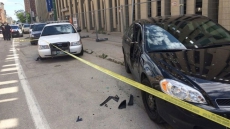VANCOUVER — Ten members from British Columbia's Okanagan Indian Band have been selected for specialized training to learn how to rid their reserve of the buried bullets and bombs that have accumulated over a century.
Military training dating back to the Boer War has littered spent and unexploded ordinance across thousands of hectares of two areas on the First Nation's land near Vernon, B.C., said Chief Coun. Byron Louis in an interview.
This September, three band members will head to Texas A&M University where they'll spend about 200 hours learning how to work safely and identify ordinance "hot spots," he said. One member has already received training and six more members will follow over the next two years.
The effort is part of a federal remediation plan that despite its multimillion-dollar price tag is "woefully inadequate," especially when developers have been knocking on the band's door, Louis said.
"If you started with 100 people on one end of our reserve and went north and just worked your way north with 100 people, in 10 years you would not finish."
The band has one estimate that sets the cleanup cost at $200 million.
Daniel Blouin, a spokesman for the Department of National Defence, said the government is spending approximately $750,000 a year on remediating the lands and plans to double that amount next year.
He said the government is working with the band to prioritize the remediation based on their economic development plan.
"Until a full assessment is completed, and a mutually agreeable solution is in place, it is not possible to estimate the scope of the work to any degree of precision," Blouin said.
The land and rolling hills overlooking Okanagan Lake and valley is covered in grasslands with mixed-timber and is dotted by small and medium-sized lakes.
"You know it's land of very high value and when you start looking at prices of property in the Okanagan, pretty soon you find that we're sitting on some considerable lands for development opportunities," Louis said.
Since the turn of the 20th Century, Canadian soldiers have used the area to train, especially during the First, Second and Korean Wars, said Louis.
Some band members can still recall artillery rounds flying over their reserve and landing on nearby training ranges, he said.
"They used to plow up on their field and every once in a while, they'd find these tail fins ... of a mortar and take the mortar and go throw it on the rock pile," said Louis. "By the grace of God those things never exploded."
He said one clean up project in August 2004 identified approximately 900 kilograms of military debris and about 26 live mortar rounds covering less than half a hectare.
"What would happen if some of these developers actually hit some unexploded ordinance and what's that going to do in terms of land value," he said.





